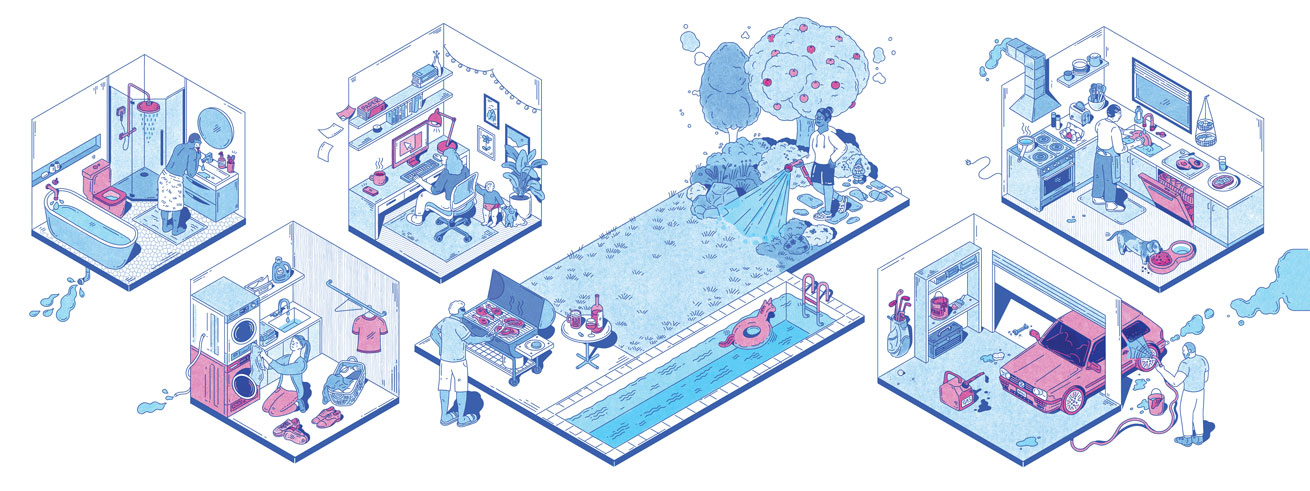With much of the West in a historic and unrelenting megadrought—more than 40 percent of which is the result of human behavior—the United States is in hot water.
According to a new study published in the British journal Nature Climate Change, the past 22 years are the driest in more than 12 centuries. CAS professor Karen Knee, a water resources expert and chair of AU’s Department of Environmental Science, says that as global warming progresses, “the intense droughts we’re seeing in the West and other places are expected to become more severe, more common, and more lasting.” In fact, 40 of 50 state water managers expect shortages of some degree over the next decade, according to a report from the Government Accountability Office.
The megadrought has parched a huge swath of the West, with 95 percent of 11 states in the region experiencing drought conditions, according to the US Drought Monitor. In summer 2021, two of the largest reservoirs in North America, Lakes Mead and Powell—which supply water from the Colorado River to tens of millions of people—reached their lowest levels in recorded history.
But despite the nation’s water woes, there’s a flood of things we can do as individuals to become more conscious consumers of this precious resource, Knee says.
Even though the average American family uses more than 300 gallons of water per day, “a lot of our usage is not reflected in our water bill. It’s the foods we eat and the products we buy,” Knee says. “A lot of this can be complicated, but in some cases it’s very simple. There’s no reason to have big, lush lawns in arid parts of the country, or to have fountains in the middle of the desert. There’s no reason to take 30-minute showers.”
Here, we pull back the (shower) curtain to offer a revealing look at just how much water the average American flushes down the drain each day.
Bathroom: A 10-minute shower takes 20 to 50 gallons, while a soak in the tub saps 36. It takes 1 gallon each to shave and wash our face, 2 to brush our teeth, and 3 to flush the toilet.
Laundry room: Before a pair of jeans and a T-shirt even make it into the washing machine—which uses 25 to 40 gallons of water per load—it takes 1,800 and 713 gallons, respectively, to grow the cotton necessary to produce them. Footwear also contributes to our water footprint: it takes 2,113 gallons to make a pair of sneakers and 3,626 for leather shoes.
Home office: Hold the phone: it requires a ridiculous amount of water—3,400 gallons—to make a smartphone, 400 for a computer, and 1.3 for a single sheet of paper. A 60-watt lightbulb, left on for 12 hours a day, represents an annual outflow of 6,000 gallons, and it takes 37 to make a cup of coffee before we even pop a pod into the Keurig. As for our infant “coworker,” it takes 9 gallons of water to produce his disposable diaper.
Yard: That lush green lawn comes at a cost: 72 gallons to water a 500- to 1,000-square-foot patch of grass. A swimming pool—if left uncovered, year-round—is even more of a drain, using 23 gallons per day. But that’s a mere trickle compared to what’s for dinner: 1,799 gallons go into a 16-ounce steak; 468 into a pound of chicken, 872 into a gallon of wine; 20 into a pint of beer; and 18 into a single apple for a homemade pie.
Garage: It takes 39,000 gallons of water to manufacture the average auto; another 100 to wash it; and 2.5 to produce every gallon of gas we pump into it. The old gallon of water-based paint in one corner of the garage takes 13 gallons to make, while the golf clubs in the other are ready for a round on a course that uses an average of 200 million gallons a year.
Kitchen: As much water as it takes to clean our plates—9 to 27 gallons by hand or 6 to 16 gallons by dishwasher—it requires even more to produce the food we put on them. Here’s a taste: a slice of bread, 11 gallons; an avocado, 60 gallons; and a single egg, 120 gallons. And it’s not just human kibble—it takes 200 gallons of water to produce one bowl of Fido’s food.
